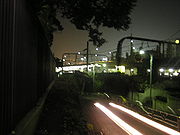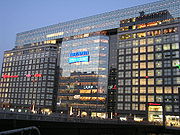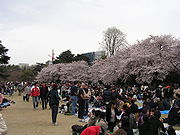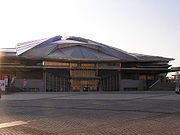
Sendagaya
Encyclopedia


Shibuya, Tokyo
is one of the 23 special wards of Tokyo, Japan. As of 2008, it has an estimated population of 208,371 and a population density of 13,540 persons per km². The total area is 15.11 km²....
ward 渋谷区), one of Tokyo
Tokyo
, ; officially , is one of the 47 prefectures of Japan. Tokyo is the capital of Japan, the center of the Greater Tokyo Area, and the largest metropolitan area of Japan. It is the seat of the Japanese government and the Imperial Palace, and the home of the Japanese Imperial Family...
(東京都), Japan
Japan
Japan is an island nation in East Asia. Located in the Pacific Ocean, it lies to the east of the Sea of Japan, China, North Korea, South Korea and Russia, stretching from the Sea of Okhotsk in the north to the East China Sea and Taiwan in the south...
's (日本) special 23 wards
Special wards of Tokyo
The are 23 municipalities that together make up the core and the most populous part of Tokyo, Japan. Together, they occupy the land that was the city of Tokyo before it was abolished in 1943. The special wards' structure was established under the Japanese Local Autonomy Law and is unique to...
.
Introduction

Shinjuku Gyoen
is a large park with an eminent garden in Shinjuku and Shibuya, Tokyo, Japan. It was originally a residence of the Naitō family in the Edo period. Afterwards, it became a garden under the management of the Imperial Household Agency of Japan...
(新宿御苑) (Shinjuku Imperial Gardens) to the north (an area in Sendagaya, 6-chome, or 千駄ヶ谷6丁目, is actually located within the gardens). The National Stadium (国立競技場), also known as Olympic Stadium, Tokyo is located to the east. Meiji Shrine
Meiji Shrine
', located in Shibuya, Tokyo, is the Shinto shrine that is dedicated to the deified spirits of Emperor Meiji and his wife, Empress Shōken.-History:...
(明治神宮) and Yoyogi Station
Yoyogi Station
is a railway station located in Shibuya, Tokyo, Japan, several hundred meters south of Shinjuku Station. It is station E-26 under Toei's numbering system.-JR East:...
(代々木駅)are found to the west. Jingumae (神宮前) and Harajuku
Harajuku
Harajuku is the common name for the area around Harajuku Station on the Yamanote Line in the Shibuya ward of Tokyo, Japan....
(原宿) are directly south. Many important cultural and sporting venues are located in and around Sendagaya.
Sendagaya is a mix of old, new, and incredibly futuristic designs. From Sendagaya Station
Sendagaya Station
is a railway station operated by East Japan Railway Company and located in Shibuya, Tokyo, Japan.-Around the station:Located in front of the station is Kokuritsu Kyogijo Station on the Toei Ōedo Line....
(千駄ヶ谷駅), the main station in Sendagaya, bustling Shinjuku is a tranquil 10 minute walk away along the Imperial Gardens' western wall. Sendagaya Entrance to the gardens is 2 minutes away from Sendagaya Station.
Sendagaya, particularly 3-chome, is home to dozens of clothing and accessory design workshops, studios, offices, and fashion related agencies, including the mega-brand Bape. The narrow streets are filled daily with the hustle and bustle of courier companies picking up next season's designs and delivering the finished product.
Theatre
Sendagaya includes several theaters and organizations related to the arts, such as the National NohNoh
, or - derived from the Sino-Japanese word for "skill" or "talent" - is a major form of classical Japanese musical drama that has been performed since the 14th century. Many characters are masked, with men playing male and female roles. Traditionally, a Noh "performance day" lasts all day and...
Theatre, designed by Hiroshi Oe and completed in 1983. Also, the Kinokuniya Southern Theater, the classical music Tsuda Hall (津田ホール), the Japan Federation of Composers, the Japan Theatre Arts Association, the Japan Association of Music Enterprises (ì˙ñ{âπäyéñã∆é“ã¶âÔ), the Tokyo Nikikai Opera Foundation, a troupe of opera singers dedicated to promoting and developing the western music movement, and the Japanese Centre of the International Theatre Institute are located in Sendagaya.

Shrines
A few minutes walk from the station, is the Hato Mori HachimanHachiman
In Japanese mythology, is the Japanese syncretic god of archery and war, incorporating elements from both Shinto and Buddhism. Although often called the god of war, he is more correctly defined as the tutelary god of warriors. He is also divine protector of Japan and the Japanese people...
Shrine (鳩森八幡神社), an oasis of calm with its 300-year old pine trees. This small shrine is a place of historical importance in Shibuya. Within the shrine, there is a stage for Japanese arts' performances and a fuji-tsuka (富士塚), a replica of Mount Fuji
Mount Fuji
is the highest mountain in Japan at . An active stratovolcano that last erupted in 1707–08, Mount Fuji lies about south-west of Tokyo, and can be seen from there on a clear day. Mount Fuji's exceptionally symmetrical cone is a well-known symbol of Japan and it is frequently depicted in art and...
made from stones carried from Mt. Fuji. Fuji-tsuka were common in Japan during the Edo Period
Edo period
The , or , is a division of Japanese history which was ruled by the shoguns of the Tokugawa family, running from 1603 to 1868. The political entity of this period was the Tokugawa shogunate....
and were constructed to allow people to make a symbolic pilgrimage to the sacred Mt. Fuji when travel between domains (han) was not permitted for commoners under most circumstances. This fuji-tsuka is one of the few that survives in Tokyo.
Sports
A number of sports' complex are found nearby Sendgaya Station including the Olympic Stadium, Tokyo (which actually sits in Shinjuku-ku) built for the 1958 Asian GamesAsian Games
The Asian Games, officially known as Asiad, is a multi-sport event held every four years among athletes from all over Asia. The Games were regulated by the Asian Games Federation from the first Games in New Delhi, India, until the 1978 Games. Since the 1982 Games they have been organised by the...
and subsequently used for the 1964 Summer Olympics
1964 Summer Olympics
The 1964 Summer Olympics, officially known as the Games of the XVIII Olympiad, was an international multi-sport event held in Tokyo, Japan in 1964. Tokyo had been awarded with the organization of the 1940 Summer Olympics, but this honor was subsequently passed to Helsinki because of Japan's...
. Near the stadium, are other important venues, such as Meiji Jingu Skate and Curling Rink and Futsal Courts, the Meiji-Jingu Stadium used by the Yakult Swallows baseball
Baseball
Baseball is a bat-and-ball sport played between two teams of nine players each. The aim is to score runs by hitting a thrown ball with a bat and touching a series of four bases arranged at the corners of a ninety-foot diamond...
team, Jingu Secondary Stadium, Chichibunomiya rugby stadium
Chichibunomiya rugby stadium
in the Aoyama district of central Tokyo is the spiritual home of Japanese rugby union and the headquarters of the Japan Rugby Football Union.-Facilities:...
, and the Tokyo Metropolitan Gymnasium
Tokyo Metropolitan Gymnasium
is a world-class sporting complex in Sendagaya, Shibuya, Tokyo, Japan. Built in 1954 for the World Wrestling Championship, it was also used as the venue for gymnastics events at the 1964 Summer Olympics...
(東京体育館).

Japanese architecture
' originated in prehistoric times with simple pit-houses and stores that were adapted to a hunter-gatherer population. Influence from Han Dynasty China via Korea saw the introduction of more complex grain stores and ceremonial burial chambers....
is on display directly in front of Sendagaya Station at the metro gymnasium, which houses an Olympic size swimming pool, as well as a shorter 25m pool; an outdoor oval running track; a weight training room; and large indoor arena (photo opposite). The futuristic designed main arena, half built below ground, which seems to hover over the surrounding area, is used for a number of national and international sporting events, including the WTA
Women's Tennis Association
The Women's Tennis Association , founded in 1973 by Billie Jean King, is the principal organizing body of Women's Professional Tennis. It governs the WTA Tour which is the worldwide professional tennis tour for women. Its counterpart organization in the men's professional game is the Association of...
Toray Pan Pacific
Toray Pan Pacific Open
The is a WTA Tour affiliated professional tennis tournament for women, held every year since 1984 on in Tokyo, Japan. It is classified on the WTA Tour as a Tier I tournament since 1993. The event has traditionally been played on indoor carpet at the Tokyo Metropolitan Gymnasium, but the 2008 event...
Tennis Championships. The Tokyo Metropolitan Gymnasium, built in 1991, was designed by Japanese architect and Pritzker Prize
Pritzker Prize
The Pritzker Architecture Prize is awarded annually by the Hyatt Foundation to honour "a living architect whose built work demonstrates a combination of those qualities of talent, vision and commitment, which has produced consistent and significant contributions to humanity and the built...
winner Fumihiko Maki
Fumihiko Maki
is a Japanese architect and currently teaching at Keio University SFC.- Biography :After studying at the University of Tokyo he moved to the Cranbrook Academy of Art in Bloomfield Hills, Michigan, and then to Harvard Graduate School of Design. In 1956, he took a post as assistant professor of...
.
Embassies
- Embassy of the Congo, Democratic Republic of (Sendagaya 3-chome)
- Embassy of the Kingdom of Morocco (2-chome)
Schools
- Tokyo Design Academy (東京デザイン専門学校) (Sendagaya 3-chome)
- Nippon Design College (日本デザイン専門学校) (Sendagaya 5-chome)
- Tsuda School of Business (津田スクールオヴビズネス) (Sendagaya 1-chome)
Other

- Cystem Gallery with its giant Darth Vader like statue, "Nagoya", out front (Sendagaya 3-chome)
- G A Gallery, designed by Makoto Suzuki, is the gallery of Yukio Futagawa (Sendagaya 3-chome]]
- NTT DocomoNTT DoCoMois the predominant mobile phone operator in Japan. The name is officially an abbreviation of the phrase, "do communications over the mobile network", and is also from a compound word dokomo, meaning "everywhere" in Japanese. Docomo provides phone, video phone , i-mode , and mail services...
Yoyogi Building which resembles New York's Empire State Building (Sendagaya 5-chome) - Takashimya Times SquareTakashimayais a large Japanese department store chain.Founded in 1829 in Kyoto by Iida Shinkichi as a retailer of used clothing and cotton cloth, the store now has outlets throughout Japan and also in Taipei, Paris and Singapore....
, located at the southern exit of Shinjuku Station (Sendagaya 5-chome) - Kinokuniya Book Store (Sendagaya 5-chome)
- Japanese Communist PartyJapanese Communist PartyThe Japanese Communist Party is a left-wing political party in Japan.The JCP advocates the establishment of a society based on socialism, democracy and peace, and opposition to militarism...
Central Committee Headquarters (Sendagaya 4-chome) - Glaxo Smith Kline (Pharmaceuticals) Japan Head Office (Sendagaya 4-chome)
- Shiseido (Tokyo Head Office) (Sendagaya 5-chome)
- Fujita (Construction) (Sendagaya 4-chome)
- NIPPN Flour Mills Co, Ltd. Head Office (Sendagaya 5-chome)
- GAP Japan Head Office (Sendagaya 5-chome)
- Japan ShogiShogi, also known as Japanese chess, is a two-player board game in the same family as Western chess, chaturanga, and Chinese Xiangqi, and is the most popular of a family of chess variants native to Japan...
(Japanese chess) Hall. This is the location for the recording of NHKNHKNHK is Japan's national public broadcasting organization. NHK, which has always identified itself to its audiences by the English pronunciation of its initials, is a publicly owned corporation funded by viewers' payments of a television license fee....
's exciting shogi show. - Sazaby/Afternoon Tea (Sendagaya 2-chome)
- Sendagaya Intes, a delicate, thin and narrow glass office building (Sendagaya 1-chome)
- Tel Well Japan (NTT Group) (Sendagaya 5-chome)
- The Fujita Vente Museum used to be found here, but has been closed. The building now belongs to GlaxoSmithKline.

Rail and Subway Stations
JRJapan Railways
The Japan Railways Group, more commonly known as , consists of seven for-profit companies that took over most of the assets and operations of the government-owned Japanese National Railways on April 1, 1987...
Sendagaya Station on the Chūō-Sobu Line
Chuo-Sobu Line
The is a railway line located in Tokyo and Chiba Prefecture, Japan. Part of the East Japan Railway Company network, it runs on separate tracks along the right-of-way of the Chūō Main Line and Sōbu Main Line , providing service between Mitaka Station in the cities of Mitaka and Musashino and...
(中央総武線) is the main station. Yoyogi Station
Yoyogi Station
is a railway station located in Shibuya, Tokyo, Japan, several hundred meters south of Shinjuku Station. It is station E-26 under Toei's numbering system.-JR East:...
(JR Yamanote Line
Yamanote Line
The is commuter rail loop line in Tokyo, Japan, operated by East Japan Railway Company . It is one of Tokyo's busiest and most important lines, connecting most of Tokyo's major stations and urban centres, including the Yūrakuchō/Ginza area, Shibuya, Shinjuku, and Ikebukuro, with all but two of its...
(山手線) and Chūō-Sobu) and Shinanomachi Station
Shinanomachi Station
is a railway station operated by East Japan Railway Company and located in Shinjuku, Tokyo, Japan.- Surrounding area :* Keio University Medical School Hospital* Meiji-Jingu Stadium* Soka Gakkai Headquarters* Minon Music Museum-History:...
(信濃町駅)are the JR Chūō-Sobu Line stations on either side of Sendagaya.
Kokuritsu Kyogijo Station
Kokuritsu Kyogijo Station
, also known as Tokyo Taiikukan Mae, is a Tokyo subway station located in Sendagaya, Shibuya and Shinanomachi, Shinjuku. Situated on the Toei Ōedo Line, the station is operated by the Tokyo Metropolitan Bureau of Transportation....
(E-25), on the Toei Oedo Line
Toei Oedo Line
The is a subway line in Tokyo, Japan operated by the Tokyo Metropolitan Bureau of Transportation . It commenced full operations on December 12, 2000; using the Japanese calendar this reads "12/12/12" as the year 2000 equals Heisei 12...
(都営大江戸線), sits in front of Sendagaya Station.
Kitasando Station
Kitasando Station
is a subway station on the Tokyo Metro Fukutoshin Line located in Shibuya, Tokyo, Japan. Its station number is F-14.This station was opened on June 14, 2008.-Adjacent stations:...
(北参道駅), nearby on Meiji Dori (明治道り), on the new Fukutoshin Line (副都心線), is run by the Tokyo Metro.
A little further on foot are the stations of Gaienmae (外苑前) in Minato-ku
Minato, Tokyo
is one of the 23 special wards of Tokyo, Japan. As of 1 March 2008, it had an official population of 217,335 and a population density of 10,865 persons per km². The total area is 20.34 km².Minato hosts 49 embassies...
(港区) on the Ginza Line(銀座線), Omotesandō on the Ginza Line, Chiyoda Line (千代田線) and Hanzomon Line (半蔵門線) and Meiji Jingu (明治神宮) on the (Chiyoda Line).
Also, JR Harajuku
Harajuku
Harajuku is the common name for the area around Harajuku Station on the Yamanote Line in the Shibuya ward of Tokyo, Japan....
on the Yamanote Line can be found nearby.
The Royal Platform (宮廷ホーム), used by the Japanese Imperial Family during special occasions, is located along the Yamanote Line in Sendagaya 3-chome.
Roads
The Shuto ExpresswayShuto Expressway
is a network of toll expressways in the Greater Tokyo Area of Japan. It is operated and maintained by the .Most routes consist of elevated roadway above other roads or over water, and have many sharp curves which require caution to drive safely...
(首都高速道路 Shuto-kōsoku-dōro ) passes above Sendagaya running beside the Sobu Line tracks. On/Off ramps for the expressway are in Sendagaya and the neighbouring Shinanomachi area.
Two major urban routes - Meiji Avenue (明治通り (Rt. 305) and Gaien Nishi Avenue (外延西道り) (Rt 418) - run through Sendagaya.
External links
- Metropolis Travel, Sendagaya (en)
- Shibuya City Hall (en)
- Tokyo Metropolitan Gymnasium Architect Report (en)
- Tokyo Metropolitan Gymnasium (jp)
- National Noh Theatre (en)
- Japan Shogi Association (jp)
- Embassy of the Kingdom of Morocco (en)
- Tokyo Design Academy (en)
- Nippon Design College (jp)
- Japanese Communist Party (en)

